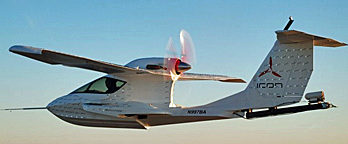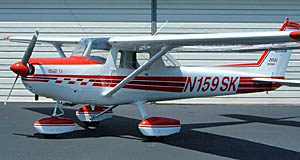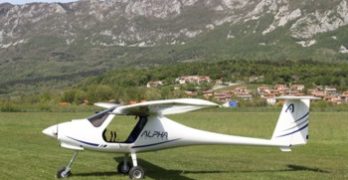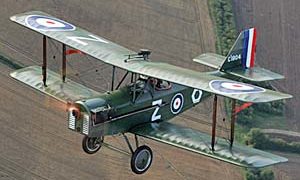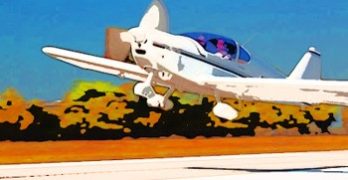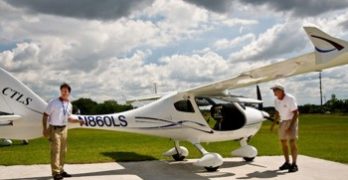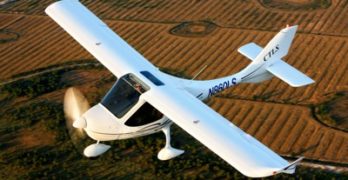*** While out west on business travel I had the chance to fly the latest SLSA on the List, the South African Sling. Earlier I’ve written about the all metal LSA’s round-the-world flight but now this low wing design is being made available for sale to Americans.
*** On a gorgeous Southern California day, Matt Litnaitzky and his associate Ryan Ruel took a 25-minute jaunt from the Torrence airport to the Camarillo Airport in Ventura. (This compares marvelously to a good hour and a half drive on the seemingly endless and always crowded L.A. freeway system.) Ryan cooled his jets in the Waypoint Cafe while Matt and I went aloft in silky smooth air to see how Sling turned out. In a word: beautifully.
*** Handling on the newest LSA is clearly the product of careful engineering and a patient development schedule.
Search Results for : CT AND hand control
Not finding exactly what you expected? Try our advanced search option.
Select a manufacturer to go straight to all our content about that manufacturer.
Select an aircraft model to go straight to all our content about that model.
Is “Spin Resistance” a Big Deal? Well, Yes!
On Memorial Day I had a chance to visit Icon Aircraft and spend some time with CEO Kirk Hawkins. We met seven years ago — just after the SP/LSA rule was released — near the beginning of his ambitions to create an entirely clean-sheet LSA amphibian.
*** Recently, Icon released the video appearing below to tout their spin resistant airframe (or SRA). Aviation and mainstream media jumped on this story and you may see other reports. I reported work toward this earlier and it’s been some time coming. Why the wait? From my first-hand experience with Cirrus Design and the development of their SR20, I have a bit of inside knowledge on this subject.
*** Cirrus also tried to grab the golden ring of SRA, as did their then-close competitor Columbia Aircraft (the two companies won their Part 23 Type Certificate within days of one another). Neither succeeded.
Older Gentleman Versus Enthusiastic Teenager
Recently, an AvWeb video stirred controversy among many LSA fans; I heard from several and that usually means more feel similarly. The subject concerned the value and challenges of LSA as flight trainers compared to old standards like Cessna 150s. I want to express another view.
*** Are LSA harder to fly, specifically, are they harder to land? The best way to respond is to say that they are different. In fact, that’s what Cessna’s top demo pilot says about Skycatcher compared to Cessna 150s and 172s. Here are some reasons why: • LSA are lighter so they tend to be affected by wind eddies more than a heavier airplane; • LSA generally have more responsive handling and commonly use joysticks versus yokes which, due to increased leverage, means pilots can more easily overcontrol them. Many are lighter in pitch than a Cessna 150 which can cause PIOs. Some say the lighter handling makes a better pilot and if you learn in a LSA, you won’t notice any great challenge; • LSA perform better, especially in glide so they meet the runway at shallower angles, which demands somewhat more finesse.
Pipistrel Comes Through Again
Just a few short months ago I posted an announcement from Pipistrel about its upcoming, mid-$80K ALPHA Trainer, targeted for flight schools and already bought in significant quantities by the Indian Air Force as a military primary trainer. *** ALPHA was promised for April, and Pipistrel nailed it – how often do we see that in manufacturing?Pipistrel is the same progressive Slovenian company that won the CAFE electric flight competition last year with the Taurus Electro G4 and has gained a growing reputation in the sport aviation industry for innovative, high-performing, highly efficient aircraft such as the Virus and Sinus S-LSA.After keeping its promise to debut the ALPHA in April at the European AERO show, word comes from Ivo Boscarol and company of the successful conclusion of flight testing. The ALPHA is now in production. *** The original concept was to create a do-it-all trainer that would garner substantial orders, enabling mass production economies of scale that would keep costs affordable for everyone.
Aero 2012: Day 3 — Still More New Aircraft!
As Aero 2012 moves toward a conclusion our wandering reporter updates you on several more attractive aircraft. All photos by Dave Unwin —DJ ||||
Having already decided that the Cicare Spirit was pretty minimalist as far as helicopters go, you may imagine my surprise when I saw an even more minimalist machine! This was the Hungarian Hungarocopter, which took helicopter minimalism to an entirely new level! Powered by either a 136- or 165-horsepower Subaru, and with a gross weight of 992 pounds, it definitely looked like flying it would be a bit of a thrill! *** As usual the show featured a fair few curiosities, and my interest was piqued when I spotted a machine that looked very much like a Cessna, with “Skylane” on the tail. As it quite clearly wasn’t a Skylane (being nowhere near big enough) I investigated further and discovered that it was a new-ish German ultralight powered by an 80-horsepower Rotax.
Cub Replicas Are Popular… SE5 Nostalgia, Anyone?
In this retro installment, Dave Unwin reviews an 85% WWI fighter. Dave will soon start reporting from the German Aero show. —DJ ||||
Watching the world drift by under a pair of sturdy, wire-braced wings is particularly special. Wind wails in the wires and the engine growls contentedly. Nearly one hundred years after the “Big War,” I flew a scale replica of one of the most famous fighters of that era: the iconic SE5a. *** Looking remarkably realistic from a distance, I drew nearer wondering if the similarities were only skin (fabric?) deep. Knowing the basic data of a full-scale SE, I was surprised when a quick calculation on the back of my kneeboard revealed my ship known as “Z” actually has a better power-to-weight ratio than a real SE5a! It also has a higher wing loading. *** Z is painted to resemble the personal aircraft of one of the war’s top-scoring aces, Major W.
Lessons From The Field, Part Deux
Time to wrap up this week’s discussion with John Lampson, CFII and veteran Flight Design CTLS instructor. *** Our topic: How and why are LSA different than GA airplanes and what transition challenges do they present for experienced GA pilots?”LSA really perform,” says John. “When you add power in the CT, it wants to just leap off the ground. That’s not true of most heavier GA airplanes.” *** “As I said earlier, GA experience shouldn’t hold pilots back in an LSA. But I’ve noticed they’re often surprised at the lighter, more dramatic, responsive feel of LSA, especially when they make the exact same control inputs that they’re used to for a GA airplane.” *** “New pilots on the other hand, with no prior flying experience, have no preconceptions. I can teach them from the ground up. They don’t have to combat and unlearn those old habits first.” *** Does that mean baby blue students get with the program quicker?
Lessons From The Field
My good pal John Lampson, the 6,000 hour CFII who took me through my Sport Pilot training a few years back now, continues the good fight to put well-trained, safe Light Sport Aircraft pilots in the air.John’s a CFII, so he teaches for all the GA ratings, but he’s getting a lot of students putting in LSA time on the Flight Design CTLS that’s on leaseback out of Premier Flight Center in Hartford, CT. *** John’s done well over 1,000 hours of training by now in the CT so I thought he’d be a great source of regular tips on learning to fly, or transition to, light sport flight. We got to chatting on which topic to kick off this training discussion with and before long settled on something we’d covered before and that I’ve written about in the past: how is flying an LSA different, especially for rated GA pilots used to heavier, less responsive aircraft, and what challenges does that present to the student?
Volkswagen for Drivers; Volksplane for Pilots
Barely had we published the announcement of Dave Unwin as a new ByDanJohnson.com contributor but what two visitors wrote asking for a review of Dave’s affordable VP-1. We’re pleased to answer that request quickly. Enjoy…! |||| Far below the sun-splashed wings the autumn shadows are lengthening across the Lincolnshire Wolds. Sunset won’t be long, and I’ve still got around 40 nm to go. Thank goodness I’ve got a tailwind, for although the Evans VP-1 Volksplane is many things, one thing it isn’t… is fast! *** So, how does it fly? Well, with only 60 hp the acceleration is far from startling, and it is important to pick up the tail, particularly if the grass is long as the tailwheel is small. Fortunately the large stabilator becomes effective quickly, as does the rudder. No problem keeping her straight. However, VP-1 is hardly over-powered; you must “fly the wing.” You don’t quite have to coax it into the air, but you can’t bully it either.
Light-Sport Aircraft… What? How? Why?
Light-Sport Aircraft are the newest category of aircraft as defined by FAA, the government regulatory agency for aviation. The new breed of aircraft – 109 models in just five years of astonishingly rapid development – offer affordable purchase prices, low cost of operation, spacious interiors, the latest instrument innovations, energetic performance and lively handling. Every one of these new airplane meets new industry standards.
Any Light-Sport Aircraft (LSA) must fit within the following parameters: A maximum of two occupants, a maximum take-off weight of 1,320 pounds (seaplanes can weigh 1,430 pounds); a 45-knot clean stall speed; a 120-knot top speed at maximum continuous power; a single, non-turbine engine; and fixed landing gear (though amphibious floatplanes can have “repositionable” gear). Some are called Special Light-Sport Aircraft (SLSA) if they are fully manufactured and ready-to-fly. A manufacturer can also offer a kit aircraft based on the SLSA; it’s called an Experimental LSA or ELSA.
- « Previous Page
- 1
- …
- 35
- 36
- 37
- 38
- 39
- …
- 62
- Next Page »



